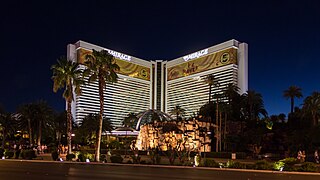
A world's fair, also known as a fun exhibition or an expo, is a large global exhibition designed to showcase the achievements of nations. These exhibitions vary in character and are held in different parts of the world at a specific site for a period of time, typically between three and six months.

The Louisiana Purchase Exposition, informally known as the St. Louis World's Fair, was an international exposition held in St. Louis, Missouri, United States, from April 30 to December 1, 1904. Local, state, and federal funds totaling $15 million were used to finance the event. More than 60 countries and 43 of the then-45 American states maintained exhibition spaces at the fair, which was attended by nearly 19.7 million people.

Forest Park is a public park in western St. Louis, Missouri. It is a prominent civic center and covers 1,326 acres (5.37 km2). Opened in 1876, more than a decade after its proposal, the park has hosted several significant events, including the Louisiana Purchase Exposition of 1904 and the 1904 Summer Olympics. Bounded by Washington University in St. Louis, Skinker Boulevard, Lindell Boulevard, Kingshighway Boulevard, and Oakland Avenue, it is known as the "Heart of St. Louis" and features a variety of attractions, including the St. Louis Zoo, the St. Louis Art Museum, the Missouri History Museum, and the St. Louis Science Center.

The Boardwalk Hotel and Casino was a Coney Island-style hotel on the Las Vegas Strip. The property began in 1966, as a Holiday Inn. Norbert Jansen added a gift shop to the hotel in 1972, and later opened the Slot Joynt casino. In 1985, Jansen renamed the Holiday Inn as the Viscount Hotel, part of a U.S. chain. Four years later, he merged Slot Joynt with the Viscount and renamed them as the Boardwalk. It rejoined the Holiday Inn chain in 1994, through a franchise deal which eventually ended in 2002.

The Dilwara Temples or Delvada Temples are a group of Śvētāmbara Jain temples located about 2+1⁄2 kilometres from the Mount Abu settlement in Sirohi District, Rajasthan's only hill station. The earliest were built by Bhima I and supposedly designed or at least financed by Vastupala, Jain minister of Dholka. They date between the 11th and 16th centuries, forming some of the most famous monuments in the style of Māru-Gurjara architecture, famous for their use of a very pure white marble and intricate marble carvings. They are managed by Seth Shri Kalyanji Anandji Pedhi, Sirohi and are a pilgrimage place for Jains, and a significant general tourist attraction. The Dilwara temples are regarded as the most impressive among Jain temples in Rajasthan.

The Mirage is a casino resort on the Las Vegas Strip in Paradise, Nevada, United States. It is owned by Vici Properties and operated by Hard Rock International. The 65-acre property includes a 90,548 sq ft (8,412.2 m2) casino and 3,044 rooms.

Adherents of Jainism first arrived in the United States in the 20th century. Jain immigration began in earnest in the late 1960s and continues to the present day.

The Missouri History Museum in Forest Park, St. Louis, Missouri, showcases Missouri history. It is operated by the Missouri Historical Society, which was founded in 1866. Museum admission is free through a public subsidy by the Metropolitan Zoological Park and Museum District.
The Castaways was a hotel and casino on the Las Vegas Strip in Paradise, Nevada. It began in the 1930s, as a small motel called Mountain View. It became the San Souci in 1939, and underwent several ownership changes in its early years. A hotel addition opened on August 21, 1955, when the property became the Sans Souci Hotel. A casino, showroom, and restaurant were eventually opened on October 23, 1957. These facilities closed less than a year later, due to financial problems, although the hotel continued operations. Following a bankruptcy reorganization, the shuttered facilities reopened in May 1960. However, the property soon closed due to further financial difficulties.

Jainism has had a notable following in Gujarat. According to the 2011 Census of India, around 0.959% of the population of Gujarat is Jain. There are several old Jain temples that draw pilgrims from Jains around the world in places such as Palitana, Taranga, Sankheshwar, Idar.

A Jain temple, Derasar or Basadi is the place of worship for Jains, the followers of Jainism. Jain architecture is essentially restricted to temples and monasteries, and Jain buildings generally reflect the prevailing style of the place and time they were built.
Jainism is an ancient Indian religion belonging to the śramaṇa tradition. It prescribes ahimsa (non-violence) towards all living beings to the greatest possible extent. The three main teachings of Jainism are ahimsa, anekantavada (non-absolutism), aparigraha (non-possessiveness). Followers of Jainism take five main vows: ahimsa, satya, asteya, brahmacharya (chastity), and aparigraha. Monks follow them completely whereas śrāvakas (householders) observe them partially. Self-discipline and asceticism are thus major focuses of Jainism.

Eames and Young was an American architecture firm based in St. Louis, Missouri, active nationally, and responsible for several buildings on the National Register of Historic Places.

Ranakpur Jain temple or Chaturmukha Dharana Vihara is a Śvētāmbara Jain temple at Ranakpur dedicated to Tirthankara Rishabhanatha. The temple is located in a village of Ranakpur near Sadri town in the Pali district of Rajasthan.

The Palitana temples are the large groups of Jain temples located on Shatrunjaya hills near Palitana in Bhavnagar district, Gujarat, India. Also known as Padliptapur of Kathiawad in historic texts, the dense collection of over 800 small shrines and large temples here has led many to call Palitana as a "city of temples". It is one of the most sacred sites of Svetambara tradition within Jainism. These temples were built in and after the 11th century CE.

Jain Center of Southern California (JCSC) is a leading Jain Center in America. It was founded on September 15, 1979. JCSC played a major role in founding of JAINA, the umbrella Jain organization of North America and hosted the first Jaina convention in 1981.

Kushibiki Yumindo, also given as Yumeto, Yumito, and Yumeno, was a Japanese impresario responsible for organizing many international exhibitions in the late 19th and early 20th centuries.
The Canadian exhibition at the Louisiana Purchase Exposition was the country's contribution to what was commonly called the St. Louis World's Fair, held in St. Louis, Missouri, United States, in 1904. The exhibition included a showcase of Canadian natural resources and fine art.













